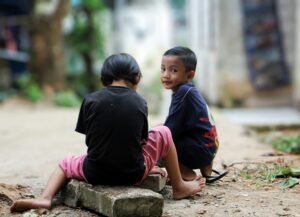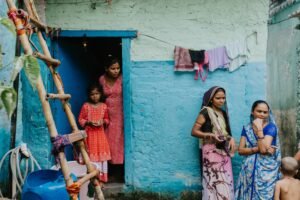
Child marriage is a complex global phenomenon that eludes easy explanations or solutions. Data studies and reports repeatedly establish that child marriage is a multifaceted problem, caused by varied but interconnected issues like abject poverty, food insecurity, lack of education, growing unemployment, patriarchal mindsets, dowry demands and inadequate access to health services.[1] The Government’s own National Family Health Survey of 2015-16[2] indicates that the percentage of girls marrying before the age of 18 is the highest among those in lower socioeconomic groups. Increasing the marriageable age is therefore unlikely to fix an issue which is systemic. Any credible effort to fight child marriage must be directed towards addressing root and branch issues of access and poverty and building a social infrastructure that will equip women to economically and socially flourish, rather than see marriage as their only viable option.
Another key aspect that remains unaddressed and contributes to the high incidence of child marriages is a lack of awareness of the existing law. In a study conducted by the Planning Commission of 10,000 persons across 10 states, it was found that less than a quarter of the respondents were even aware of the Prohibition of Child Marriage Act, 2006 (“PCMA”).[3] It is no surprise, then, that according to the National Family Health Survey of 2019-2021, almost one in four women in India in the age group 20-24 years were married before the age of 18.[4] The lack of awareness of the PCMA is reflected in the woeful failure of implementation on the ground – as per the National Crimes Record Bureau report of 2020, only 785 cases of child marriage were recorded under the PCMA in 2020 and 525 in 2019.[5] Any calibrated solution must aim to improve awareness and implementation of the PCMA so that the law doesn’t remain a dead letter but rather an active tool in deterring child marriages.
Child marriage is also a cause and consequence of teenage pregnancies. The Bill rightfully identifies tackling this as one of its objectives. However, important stakeholders like the Odisha State Commission for Protection of Child Rights have argued that increasing the marriageable age of girls will have the opposite effect, and could in fact lead to an increase in ‘unwed mothers.’ At the moment, women above 18 years can legally marry legally should situations of pregnancy, societal pressure or other factors result in them finding this necessary. However, the amendment sets the stage for a spike in unsafe abortions, foeticide, and societal stigma for unwed mothers as well as their families. Sandhyabati Pradhan, who leads Odisha’s child rights panel, also importantly flagged that “Acts like Juvenile Justice Care and Protection Act and schemes like Integrated Child Protection Scheme have scope to extend support to vulnerable children only up to the age of 18. In such circumstances, there will be no space to provide support to a child bride or groom between the age of 19 to 21 if rescued from child marriage.”[6]
Another matter of grave concern with this law is that criminalisation remains at the heart of it, despite it being touted as a “social welfare legislation”. This is particularly relevant given Indian social realities. Young women are often denied the right to choose their own partners, leading them to elope with their desired partners. Apart from this, they may also elope to escape violence, domestic abuse, forced marriage, parental retribution to romantic relationships and onerous household work.[7] A study by Partners for Law and Development (PLD)[8], which examined 83 high court and district court judgments relating to child marriage, shows that 65% of criminal cases under the Act have been filed regarding elopement cases. In 67.4% of the cases, the complaints were initiated by parents or relatives. This demonstrates the use of the Act as a tool of control by families over their children who marry against their wishes. A likely consequence of this amendment is that a higher percentage of young boys will be pushed into the legal system and will serve prison time (up to 2 years under the PCMA). This will also have deleterious consequences for young women, who oftentimes refuse to return to their families, and end up in shelter homes. Many of these young women then suffer from depression, and some even consider suicide.[9]
In most developed countries, 18 years is considered the minimum age for marriage. International instruments like the United Nations Convention on the Rights of the Child and the Convention on the Elimination of All Forms of Discrimination Against Women have set the minimum age to marry at 18 years. Domestically as well, 18 has been accepted as age one reaches adulthood. National legislations in India consider people as adults at 18 years for the purposes of voting, driving, entering into contracts, and having sexual relations. In fact, both 2008[10] and 2018[11] reports by the Law Commission recommend that the marriageable age for both boys and girls be fixed at 18, with the latter report noting that “if a universal age for the majority is recognised, and that grants all citizens the right to choose their governments, surely, they must then be also considered capable of choosing their spouses.”
Simply put, child marriage is a complex social problem. Only a multi-pronged response to the systemic causes that underpin it will be able to put an end to it. The government should ensure free and compulsory education for children till 18 years, paid and secure work opportunities for women, invest in making food and nutrition accessible, provide basic sex education for children in school and improve access to safe reproductive and health services. Such measures will also help achieve the intentions behind this Bill – namely to empower girls by allowing them to pursue higher education and enter the workforce before getting married, to improve maternal health including maternal and infant mortality rate, and to reduce instances of teenage pregnancies. Furthermore, awareness campaigns with a multi-stakeholder approach to the law are essential across India, as no law can be properly implemented if the majority of citizens are unaware of it. Merely raising the age of marriage will not solve a deeply embedded social issue; rather, as discussed above, it may have serious consequences for young men and women who will be forced to face the worst of the criminal justice system.
[1] Center for Reproductive Rights & Centre for Law and Policy Research, Ending Impugnity for Child Marriage in India: Normative and Implementation Gaps, 2018, available at: https://reproductiverights.org/sites/default/files/documents/Ending-Impunity-for-Child-Marriage-India-WebUpdate-0218.pdf
[2] Ministry of Health and Family Welfare, National Family Health Survey (NHFS – 4) – 2015 -16, December 2017, available at: – https://dhsprogram.com/pubs/pdf/FR339/FR339.pdf
[3] Pt. G.B. Pant Institute of Studies in Rural Development, Child Marriage in India: A Study of Situation, Causes and Enforcement of Prohibition of Child Marriage Act, available at: https://niti.gov.in/planningcommission.gov.in/docs/reports/genrep/Report_Child_Marriage_in_India.pdf
[4] Ministry of Health and Family Welfare, National Family Health Survey (NHFS -5) – 2019 -21, “ available at: http://rchiips.org/nfhs/factsheet_NFHS-5.shtml
[5] Bangalore Mirror, Highest number of child marriages in Karnataka, available at: https://bangaloremirror.indiatimes.com/bangalore/crime/highest-number-of-child-marriages-in-karnataka/articleshow/86333525.cms
[6] Debabrata Mohanty, Rise in foeticide, unwed mothers: Odisha child rights panel opposes marriage age law, Hindustan Times, January 5, 2022, available at: https://www.hindustantimes.com/india-news/rise-in-foeticide-unwed-mothers-odisha-child-rights-
panel-opposes-marriage-age-law-101641325804966.html
[7] Swagata Yadavar, Why Govt Move Of Raising Legal Age of Marriage For Women May Harm Instead of Benefiting Them, Article 14, December 2021, available at: https://article-14.com/post/why-govt-move-of-raising-legal-age-of-marriage-for-women-may-harminstead-of-benefiting-them-61c3e78f8f474
[8] Partners for Law and Development, Child Marriage Prosecutions in India: Case Law Analysis of Actors, Motives and Outcomes 2008-2017, available at: https://www.academia.edu/50087712/Child_Marriage_Prosecutions_in_India_Case_Law_Analysis_of_Actors_Motives_and_Outcomes_2008_2017
[9] Supra note 8
[10] Law Commission of India, Proposal To Amend The Prohibition of Child Marriage Act, 2006 and Other Allied Laws, Report No. 205, February 2008, available at – https://lawcommissionofindia.nic.in/reports/report205.pdf
[11] Law Commission of India, Consultation Paper on Reform of Family Law, 2018, available at – https://lawcommissionofindia.nic.in/reports/CPonReformFamilyLaw.pdf












